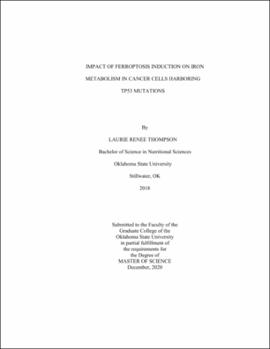| dc.description.abstract | The tumor suppressor gene TP53 is the most commonly mutated gene in human cancer, but mutations in TP53 do not just result in loss of tumor suppressor function, they can also promote cancer progression by altering cellular iron acquisition and metabolism. A newly identified role for wild-type TP53 in the mediation of iron homeostasis and cancer cell survival lies in its ability to protect against ferroptosis, a form of iron mediated cell death. The purpose of this study was to determine the extent to which TP53 mutation status effects iron-mediated cell death in response to ferroptosis induction. Using H1299 cells that are null for TP53, we generated cell lines expressing either a tetracycline-inducible wild-type TP53 gene, or a representative mutated TP53 gene from exemplary “hotspot” mutations in the DNA binding domain (248Q, 249S, 273H, 282W, 175H and 245S). These six mutation types were selected because they represent 25% of all TP53 mutations in human cancer. TP53 mutants 248Q, 273H, 245S, and 249S were more sensitive to ferroptosis than WT TP53. As iron-mediated lipid peroxidation is critical for ferroptosis induction, we hypothesized that iron acquisition pathways would be upregulated in mutant TP53 expressing cells. However, only cells expressing the 248Q, 175H, and 245S TP53 mutation types exhibited significant increases in spontaneous iron regulatory protein (IRP) RNA binding activity following ferroptosis activation. Moreover, changes in the expression of targets (e.g. TFRC and FTH1) were inconsistent with the observed differences in sensitivity to ferroptosis. These findings indicate that canonical iron regulatory pathways are bypassed during ferroptotic cell death. These results also indicate that induction of ferroptosis may be an effective therapeutic approach for tumor cells expressing distinct TP53 mutation types. | |
